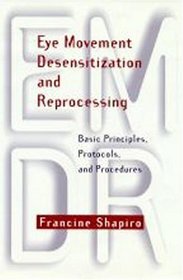Search -
Eye Movement Desensitization and Reprocessing: Basic Principles, Protocols, and Procedures
Eye Movement Desensitization and Reprocessing Basic Principles Protocols and Procedures
Author:
Eye Movement Desensitization and Reprocessing (EMDR) is a innovative clinical treatment for victims of trauma. Since its introduction in 1989, the approach has been taught to over 18,000 clinicians worldwide and has received an enormous amount of media attention. With very positive results emanating from recent studies, EMDR is now the most exte... more »
Author:
Eye Movement Desensitization and Reprocessing (EMDR) is a innovative clinical treatment for victims of trauma. Since its introduction in 1989, the approach has been taught to over 18,000 clinicians worldwide and has received an enormous amount of media attention. With very positive results emanating from recent studies, EMDR is now the most exte... more »
ISBN-13: 9780898629606
ISBN-10: 0898629608
Publication Date: 4/24/1995
Pages: 398
Rating: 1
ISBN-10: 0898629608
Publication Date: 4/24/1995
Pages: 398
Rating: 1
5 stars, based on 1 rating
Genres:
- Health, Fitness & Dieting >> Mental Health >> General
- Health, Fitness & Dieting >> Mental Health >> Post-Traumatic Stress
- Health, Fitness & Dieting >> Psychology & Counseling >> Clinical Psychology
- Health, Fitness & Dieting >> Psychology & Counseling >> General
- Health, Fitness & Dieting >> Psychology & Counseling >> Psychoanalysis
- Health, Fitness & Dieting >> Personal Health >> Stress >> Post-Traumatic Stress Disorder
- Medicine >> Specialties >> Ophthalmology
- Medicine >> Specialties >> Psychiatry >> General
- Medicine >> Internal Medicine
- Medical Books >> Medicine >> Internal Medicine >> Psychiatry




